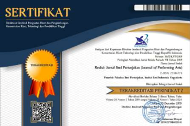Repertoar Musik Keroncong Dengan Menggunakan Idiom Musik Sunda: Implementasi Model Pembelajaran Kolaborasi pada Mata Kuliah Sejarah Analisis Musik Indonesia di Departemen Pendidikan Musik FPSD UPI Bandung
Abstract
Analysis at the Department of Music Education, FPSD, Universitas. Pendidikan Indonesia This study discusses the Implementation of Collaborative Learning Models in the History course of Indonesian music analysis at the Department of Music Education, UPI Baandung FPSD. The researcher as a lecturer in this course intends to add to the repertoire of keroncong songs, which since the 1980s keroncong song production has stalled due to competition in the Indonesian music industry. The Action Research method was used in this study to develop students' abilities in creating keroncong songs. 7 stages are used, starting from initial observation, analysis, combining ideas and ideas into big themes, evaluation exercises 1, recording and mastering. The results of this study created 10 keroncong music recordings as a product of a pure repertoire of student collaboration with the Sundanese traditional approach as the basis for creation. Future research will improve the 10 products into a more professional recording result. This research can be a reference for the application of collaborative learning models to create student work and creations in the arts.
Keywords
Full Text:
PDFReferences
Barendregt, Bart. Bogaerts, E. (2016). Merenungkan gema, Perjumpaan Musikal Indonesia-Belanda. Jakarta: Yayasan Obor Indonesia dan KITLV.
Elliott, J. D. (1995). Music Matters: A New Philosophy of Music Education. Newyork: Oxford University Press.
Ganap, V. (2000). Tugu keroncong music : hybrid genre of Portuguese sojourn. Jurnal Pengetahuan Dan Penciptaan Seni Seni, 2(4), 213–228.
Ganap, V. (2006). Pengaruh Portugis pada Musik Keroncong. Harmonia, 02(4), 1–14.
Gerlach, J. M. (1994). Is this collaboration? New Directions for Teaching and Learning, 5(14). https://doi.org/10.1002/tl.37219945903
Hardjana, S. (2003). Corat-coret musik kontemporer dulu dan kini. Jakarta: Kerjasama Ford Foundation dan Masyarakat Seni Pertunjukan Indonesia.
Harmunah. (1996). Musik keroncong sejarah, gaya dan perkembangan. Yogyakarta: Pusat Musik Liturgi.
Hasan. (2009). Action Research : Desain Penelitian Integratif untuk Mengatasi Permasalahan Masyarakat. AKSES: Jurnal Ekonomi Dan Bisnis, 4(8), 177–188. https://doi.org/10.31942/akses.v4i8.523
Hermawan, D. (2014). Fenomena Gender dalam Dongkari. Panggung, 24 No.1(212), 25–38.
Joan, L. (1989). Pianis Remaja, Buku Pegangan untuk Guru dan Murid. Jakarta: PT. Gramedia Pustaka Utama.
Latifah, K. (1983). Istilah-Istilah Musik. Jakarta: Djambatan.
Lisbijanto, H. (2013). Musik Keroncong. Jakarta: Graha Ilmu.
Margaret J. Kartomi, David Goldsworthy, Catherine Falk, B. K. (1978). Studies in Indonesian music. Centre of Southeast Asian Studies, Monash UniversityMonash University.
Mintargo, W. (2017). Akulturasi Budaya Dalam Musik Keroncong di Indonesia. Nuansa Journal of Arts and Design, 1(1), 10–22.
O’Brien, R. (1998). An Overview of the Methodological Approach of Action Research. Faculty of Information Studies. USA: University of Toronto.
Panitz, T. (1997). Collaborative versus Cooperative Learning: A Comparison of the Two Concepts Which Will Help Us Understand the Underlying Nature of Interactive Learning. Cooperative Learning and College Teaching, 8(2), 13. https://doi.org/Akses 17 Januari 2015
Rachman, A., & Utomo, U. (2017). “Sing Penting Keroncong” Sebuah Inovasi Pertunjukkan Musik Keroncong di Semarang. Jurnal Pendidikan Dan Kajian Seni, 3(1). https://doi.org/10.30870/jpks.v3i1.4066
Rohidi, T. R. (2011). Metodologi Penelitian Seni. Semarang: Cipta Prima Nusantara.
Saepudin, A. (2017). Laras , Surupan , dan Patet dalam Praktik Menabuh Gamelan Salendro Alamat Laras , Surupan , dan Patet dalam Praktik Menabuh Gamelan Salendro. Resital, 16(1), 52–64.
Suadi, H. (2017). Djiwa Manis Indoeng Disajang, Musik Dan Dunia Hiburan Tempo Dulu. Bandung: PT. Kiblat Buku Utama.
Suharto, M. (1982). Membina Paduan Suara dan Grup Vokal. Jakarta: PT. Gramedia Pustaka Utama.
Supiarza, H. (2019). Rekonstruksi Musik Keroncong Anak Muda di Kota Bandung (Universitas Padjadjaran). Retrieved from http://repository.unpad.ac.id/frontdoor/index/index/docId/24652
Supiarza, H., & Sarbeni, I. (2021). Teaching and Learning Music in Digital Era : Creating Keroncong Music for Gen Z Students Through Interpreting Poetry. Harmonia: Journal of Arts Research and Education, 21(1), 123–139.
Supiarza, H., Setiawan, D., & Sobarna, C. (2019). Pola Permainan Alat Musik Keroncong dan Tenor di Orkes Keroncong Irama Jakarta. Resital: Jurnal Seni Pertunjukan, 20(2), 108–120. https://doi.org/10.24821/resital.v20i2.2459
Suryani, N. (2010). Implementasi Model Pembelajaran Kolaboratif Untuk Meningkatkan Ketrampilan Sosial Siswa. Majalah Ilmiah Pembelajaran, 8(2).
Suryati, Widodo, W, T. (2020). Sight Singing sebagai Strategi Pembelajaran Instrumen Piano di Prodi Pendidikan Musik ISI Yogyakarta. Resital: Jurnal Seni Pertunjukan, 21(2), 99–112.
Tinzmann, M. B., Jones, B. F., Fennimore, T. F., Bakker, J., Fine, C., & Pierce, J. (1990). What Is the Collaborative Classroom? Ncrel, (January), 1–26. Retrieved from http://methodenpool.uni-koeln.de/koopunterricht/The Collaborative Classroom.htm
Wuryanto, R, L. Rohidi, R, T. Tarwiyah, T. (2016). YEN ING TAWANG ANA LINTANG: KASUS BENTUK MUSIK KERONCONG GROUP CONGROCK 17 DI SEMARANG Lucky. Catharsis : Journal of Arts Education, 5(2), 79–83.
Yampolsky, P. B. (2013). Music and media in the Dutch East Indies: Gramophone records and radio in the late colonial era, 1903--1942. Retrieved from http://search.proquest.com/docview/1428745765?accountid=13771
DOI: https://doi.org/10.24821/resital.v21i3.4740
Article Metrics
Abstract view : 0 timesPDF - 0 times
Refbacks
- There are currently no refbacks.
This work is licensed under a Creative Commons Attribution 4.0 International License.



